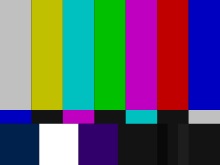|
|
| |
|
|
| |
|
|
|
|
| |
 |
| Color bars used in a
test pattern, sometimes used when no program
material is available. |
Television
Telegram television (also known as a TV) is a machine
with a screen. Televisions receive broadcasting signals
and change them into pictures and sound. The word
"television" comes from the words tele (Greek for far
away) and vision (sight).
Sometimes a television can look like a box. Older TVs
had a large cathode ray tube in a large wooden frame and
sat on the floor like furniture. Newer TVs are much
lighter and flatter.
A TV can show pictures from many television networks.
Computers and mobile devices also can be used for
watching television programs.
The television was invented in the 1920s but the
equipment was expensive and the pictures were poor. By
the 1950s, these problems had been fixed and TVs became
widespread. |
|
|
At first, all televisions used an antenna (or aerial).
This would pick up television programmes from
broadcasting stations. A TV station could be many miles
or kilometers away, and still be received. TVs can also
show movies from VCD and DVD players or VCRs. Cable TV
and Satellite television can provide more programs at
once than broadcast can. Video game consoles connect to
most modern TVs. Some computers can also use a TV as a
computer monitor. |
|
All TVs have screens where the picture is viewed. Before
the 1950s these were usually "black and white", which
made everything look grey, but all modern TVs show
colors. Most 20th century screens also had rounded
corners. That is because television screens were cathode
ray tubes. These are like heavy glass jars with one side
bulging out to form the screen.
Today flat panel displays are the usual kind. These are
usually flat rectangles with straight edges. This long
rectangle looks more like the shape of a movie theatre
screen. This is called widescreen. If a widescreen set
was 30 cm tall, it would be 53 cm wide. For this to work
best, TV shows also need to be made in widescreen.
Widescreen sets can still be any size, but they have the
same widescreen shape. |
|
|
|
|
|
|
|
|
|
|
|
|
|
|
|
|
|
|
Search Fun Easy English |
|
|
|
|
|
|
|
|
|
|
|
|
|
|
|
About
Contact
Copyright
Resources
Site Map |